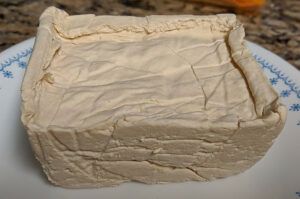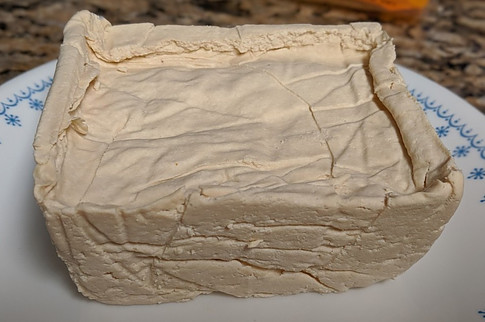Tofu is a bean curd that is made from three main ingredients: soybeans, water, and a coagulant. A coagulant is an acidic substance such as lemon juice or vinegar. The coagulating soy milk creates a curdling effect and lumps together into curds. The curd then is pressed and drained in a mold to produce the final product which is tofu. 
Tofu is often used in vegetarian cuisines to substitute meat. By itself, the taste blends in flavor. When use with other fresh ingredients such as tomatoes, onion, mushrooms, etc, it adopts and absorbs their neighbors’ flavors. It is light and become flavorful by its surrounding environment leaving you light and sated feeling in your tummy. You can also add meat to enhances the flavor.
In this article, we will learn how to make tofu from soybeans with three simple ingredients. This recipe is borrowed from www.Instructables.com. I found this recipe to be simple and straight forward. I will be adding my comments along with the existing recipe based on my experience.
As the owner of this website, I tracked down special deals for some products or services mentioned herein. As an Amazon Associate, I earn from qualifying purchases. When you use the link from this page to make a purchase, I may receive a small commission, and you may receive a great bargain – Full Disclosure.
Ingredients
3 cups (1lb) dry soybeans, Hunza Organic Soybeans (2 lbs)
water
Choose ONE from the list of coagulants below:
- 2 TBSPN Epsom Salt (magnesium sulfate) – Amazon Brand – Solimo Epsom Salt Soak, Magnesium Sulfate USP, 8 Pound
- 6 TBSPN of fresh-squeezed lemon juice
- ¼ cup vinegar
- 4 tsp Nagari (magnesium fluoride), Ohsawa Natural Nigari, 1 Pound
- 4 tsp Gypsum (calcium sulfate), Gypsum- 1 lb.

Equipment:
Food processor or blender
2 large pots
1 strainer
a mesh bag or cheesecloth
1 colander or a tofu mold
Soak and Blend
Soak the soybeans overnight. Make sure it is a big bowl because the tofu will expand. Rinse the soaked beans and discard any discolored ones and drain the water.
Pour the soybean into a blender or a food processor. You may not be able to pour all the soybeans into the blender at once. It is best to divide them into several batches. Some blenders may not handle too many soybeans at one time.
Fill the blender with enough water to cover the beans. Process the beans for a few minutes in the blender or until the beans are thoroughly ground.
Making Soy Milk
Add the processed beans to your largest pot with 12 cups of water. Stir frequently to prevent the milk from scorching the bottom and simmer for about 20 minutes under medium to low heat. This may foam up a bit so be careful not to let it boil over. If the foam boils over, lower your heat.
After 20 minutes, strain the cooked processed beans into your second pot. Use a spoon to press out as much of the milk as you can. You can use a cheesecloth to squeeze out the excess liquid as well for a quicker result. The liquid is soy milk. The solids are okara.
 If enjoy soy milk, pour out one to two cups of soy milk for your consumption at this point and continue with the rest to make tofu. Add sugar, honey, or any of your sugar substitute if desire to your soy milk. Drink it fresh and warm or refrigerate and have it cold.
If enjoy soy milk, pour out one to two cups of soy milk for your consumption at this point and continue with the rest to make tofu. Add sugar, honey, or any of your sugar substitute if desire to your soy milk. Drink it fresh and warm or refrigerate and have it cold.
The okara is full of nutritional value containing soluble and non-soluble fiber, protein, calcium, and other minerals. It seems like a waste to throw away. Here is a great article that talks more about okara along with recipes using okara –> https://justhungry.com/2006/04/milking_the_soy.html. You can dehydrate okara and freeze it for later use. When I have too much okara, I use it as compost for my garden.
Making Tofu
Heat the soy milk back up to around 180 F degrees (depending on your stove it may take from 5 to 15 minutes). In a separate bowl, dissolve your choice of coagulant (Epsom Salt, lemon juice, vinegar, gypsum or nigari) in 1½ cups of warm water.

Remove the soy milk from heat and gently stir in the coagulant. Start with a small amount and then increase as needed at 180 F degrees. In about 5 to 10 minutes the curds will separate. If it takes a little longer, you can add a little more coagulant until the liquid becomes clear and less milky. Be careful not to add too much because the tofu maybe come bitter. I used vinegar as my coagulant so the flavor is slightly sour.

Line your colander or mold with a mesh bag or cloth. Skim out curds and pour into mold. Wrap the remaining cloth on top of the tofu and even it out with a hard flat object such as a flat plate.
The mold I used look like above. Make sure to wet the cloth so it will help with smoother surface and less creases in your tofu. The picture of my homemade tofu has a lot of creases because I didn’t wet my cloth to make it straight.
Place a heavy object on top of the plate. This help squeezes and drains as much water as possible from the tofu. Less water and more setting time create firmer tofu. Leave for about 20 to 30 minutes or longer for a firmer result.
Conclusion
Making tofu is a simple process. However, if it is your first time, the process may take a little longer since you do not know what to expect. It gets easier through experience. The coagulant Nagari and gypsum are not as easy to come by. You will need to order them online like Amazon.com or visit an Asian grocery store.
The texture and taste may vary depending on the coagulant that you use. I have not tested all the different coagulant yet. I have tried gypsum before and does not require a lot of gypsum powder before the curds coagulate. Gypsum is calcium sulfate. Make sure it is food grade. It yields mild-tasting and slight sweetness to the tofu in comparison to nigari. It also adds calcium to the tofu. You can find it at home brewing supplies, online, or Chinese stores.
From my research of nigari, it consists mostly of magnesium chloride also called bittern. Nigari creates smoother texture tofu. Nigari is a mineral salt residue when the table salt is extracted from seawater and comes in liquid or powder form. It is a traditional Japanese ingredient used to make tofu.

The easiest of all coagulants to find are vinegar and lemon juice. However, they produce grainier texture and a little sour flavor to the tofu.
Click here for an article with more FAQs on coagulants –> Tofu coagulant guide: what to buy and where to find it.
If you enjoy cooking, it is a pretty fun experiment like chemistry on food reactions. From this recipe, we produce three products: soy milk, tofu, and okara.
The soy milk itself is refreshing. However, the version I made tastes leafy green and organic to me. Perhaps, I did not add enough sugar or honey. To be honest, I do not like it too much. The tofu is a little sour because I used vinegar as my coagulant. I am saving my okara to test the recipes I found online to see if it enhances the flavor of the food I make.
I am dehydrating the okara using the oven and then freeze it for longer self-life. It is a lengthy and smelly process. My kids complain about the smell. It smells like dirty laundry. Worst-case scenario, I can use it as compost for my garden.
I hope this article has been helpful to you. I love to hear about your experiences, successes, failures, and/or questions. Please leave your comments below.







![LinasD (this version uploaded by SlimVirgin) [CC BY-SA 3.0 (https://creativecommons.org/licenses/by-sa/3.0)] soymilk](https://tastyphoqueen.com/wp-content/uploads/2020/07/soymilk-190x300.jpg)

